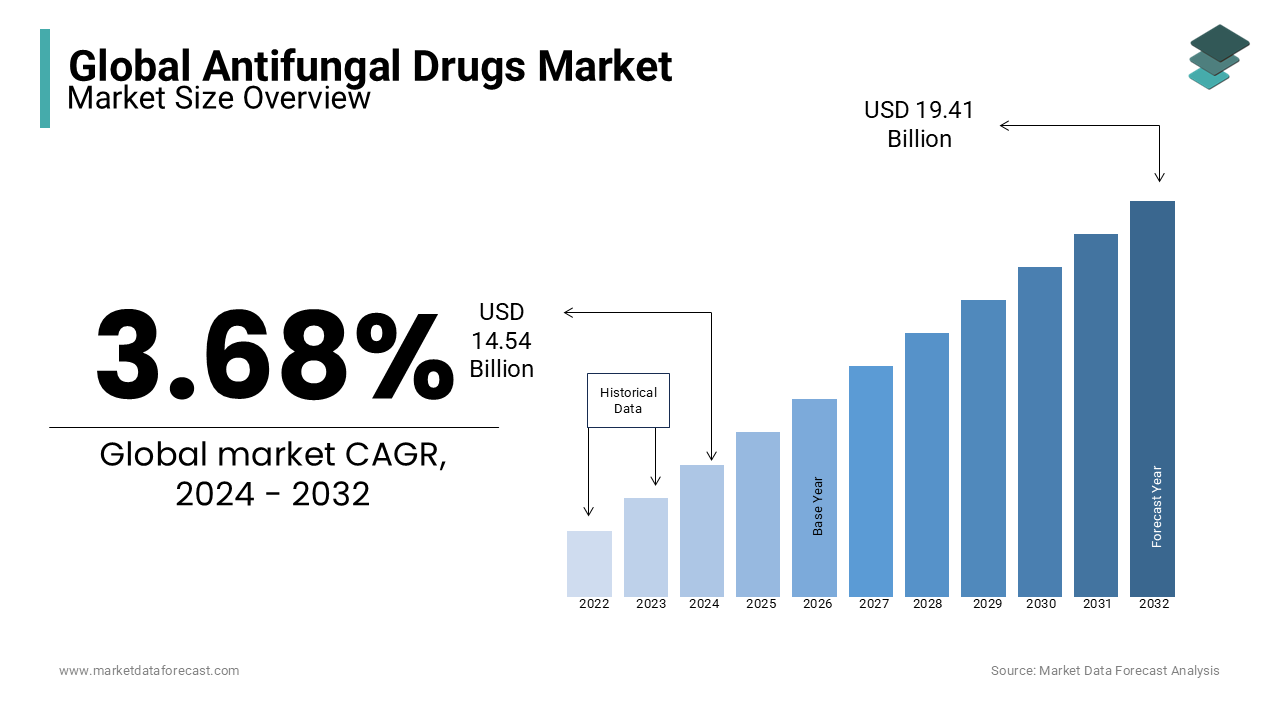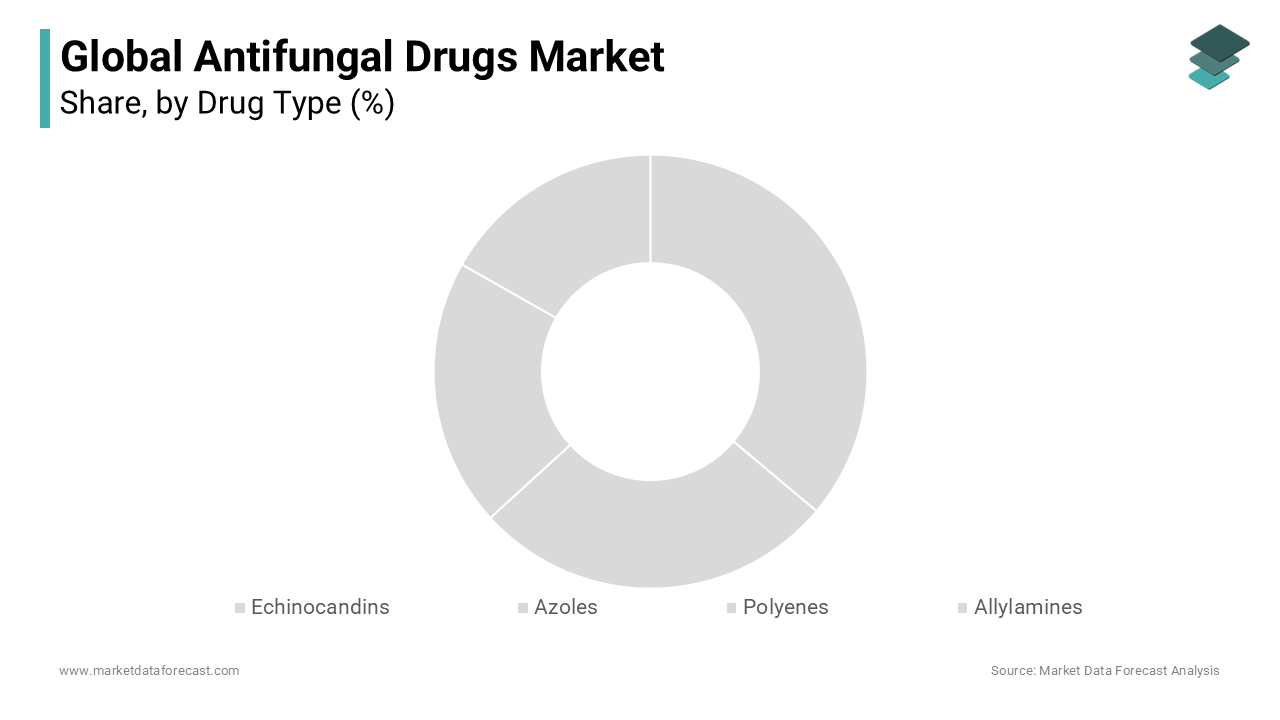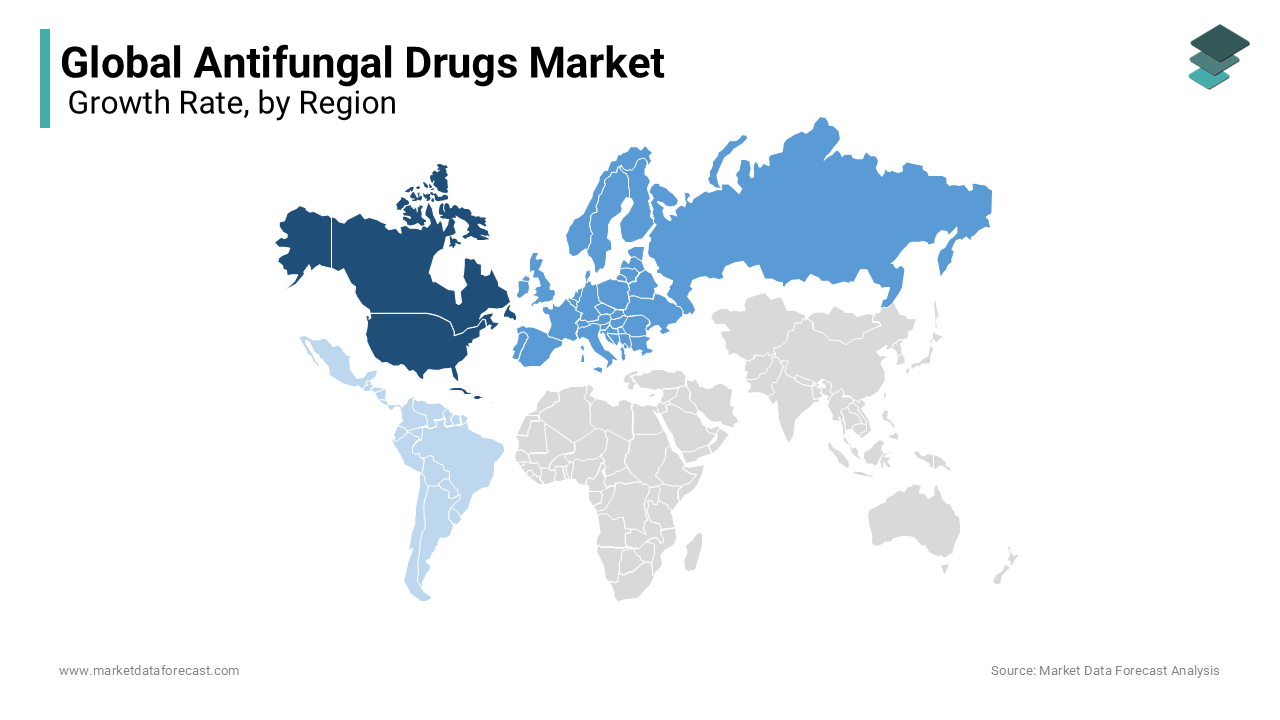Global Antifungal Drugs Market Size, Share, Trends, Growth Analysis Report – Segmented By Drug Type (Echinocandins, Azoles, Polyenes, Allylamines and Others), Therapeutic Indications (Aspergillosis, Dermatophytosis, Candidiasis and Others), Application & Region – Industry Forecast From 2025 to 2033
Global Antifungal Drugs Market Size
As per our report, the global antifungal drugs market size was valued at USD 14.54 billion in 2024. The antifungal drugs market size was worth USD 15.08 billion in 2024. It is estimated to grow at a CAGR of 3.68% and reach USD 20.14 billion by 2033.

Antifungal drugs are mainly used to treat infections like athlete's foot, ringworm, candidiasis, etc. These drugs can be easily obtained through a doctor's prescription, whereas some are available as over-the-counter drugs. The drugs are manufactured with different formulas for various infections accordingly. Fungal infections occur because organisms feed by breaking down the living tissue, also known as dermatophytes. They can utilize keratin and cause skin, hair, and nail infections. The only aim of these drugs is to prevent the fungal cell from growing by making the cell's contents break out. Unhygienic environments may lead to severe conditions causing an infection on the skin.
MARKET DRIVERS
The growing prevalence of fungal and nosocomial diseases propels the worldwide antifungal drugs market.
In addition, the growing adoption of the latest technologies in producing various drugs and offering effective treatment procedures for infectious diseases worldwide are anticipated to offer lucrative opportunities to the antifungal drugs market.
In addition, a rise in the demand to improve safety levels is lavishing the antifungal drugs market growth. Furthermore, increasing investments in research and development institutes and increasing awareness of the availability of products through digital advertisements and campaigns thrive the global antifungal drugs market's growth. Furthermore, the antifungal drugs market is predicted to grow due to increased governmental and private sector initiatives to raise awareness about various fungal illnesses. Clinical trials for the development of antifungal drugs are being conducted by market players, which is projected to boost the global antifungal drugs market's growth throughout the forecast period. The market's growth pace will be accelerated by increasing medication approvals and launches and focusing on releasing generic drugs to treat fungal infections.
MARKET RESTRAINTS
The availability of alternate substitutes silently hinders the growth of the global antifungal drugs market. In addition, the rise in side effects of long-term use of these drugs has been a challenging market growth factor. Also, fluctuations in the drug's production rate and the lack of skilled persons in manufacturing the drugs impede the market's growth rate. In addition, stringent rules and regulations by the government in approving new drugs also limit the market growth. In addition, the high cost of antifungal drugs is expected to slow the market's growth rate. Furthermore, the market for antifungal drugs is also predicted to be challenged by the growing number of resistant people to antifungal drugs and a lack of healthcare infrastructure in underdeveloped countries.
REPORT COVERAGE
|
REPORT METRIC |
DETAILS |
|
Market Size Available |
2024 to 2033 |
|
Base Year |
2024 |
|
Forecast Period |
2025 to 2033 |
|
Segments Covered |
By Drug Type, Therapeutic Indications, Application, and Region |
|
Various Analyses Covered |
Global, Regional & Country Level Analysis, Segment-Level Analysis; DROC, PESTLE Analysis, Porter's Five Forces Analysis, Competitive Landscape, Analyst Overview of Investment Opportunities |
|
Regions Covered |
North America, Europe, APAC, Latin America, Middle East & Africa |
|
Market Leader Profiled |
Gilead Sciences, Inc., Pfizer Inc., Sanofi S.A., Merck & Co., Inc., Novartis International AG, Abbott Laboratories, Bayer AG, Scynexis Inc., Enzon Pharmaceuticals, Inc., and GlaxoSmithKline Plc. |
SEGMENTAL ANALYSIS
By Drug Type Insights
The azoles segment held a significant share of the antifungal drugs market in 2024 and is expected to rise significantly during the forecast period. Azoles treat various ailments, such as yeast infection, tinea versicolor, and athlete's foot, and come in various forms, including capsules, lotions, and sterile IV solutions. These medications have better absorption and distribution qualities and fewer adverse effects and drug interactions.

On the other hand, the echinocandins segment is predicted to grow at a healthy rate during the forecast period.
By Therapeutic Indications Insights
The most prevalent systemic fungal infection, candidiasis, is anticipated to grow at a healthy CAGR during the forecast period in the global antifungal drugs market. Candida infection is a type of yeast infection caused by the genus Candida. The way it's been treated has changed over time. The judicious use of echinocandins and broad-spectrum azoles for the treatment of Candidemia, mucosal candidiasis, and invasive candidiasis are among the changes. A primary driver for the segment is the rising number of patients more sensitive to fungal infections. Furthermore, rising patient and healthcare professional awareness is expected to propel the antifungal drugs market forward.
By Application Insights
The ointment segment emerged as the worldwide antifungal drugs market leader. Over the forecast period, the market is expected to rise due to the increasing usage of topical antifungals in treating skin-related fungal diseases.
REGIONAL ANALYSIS

North America had the most significant global market share in 2024, owing to the rapid adoption of the latest technologies. In addition, introducing high-quality and low-cost drugs is prompting the market's growth rate in this region. Due to the priority review status for antifungal medications to treat antifungal infections, North America is likely to see considerable growth in the global antifungal drugs market during the forecast period. Due to improved healthcare infrastructure, an increase in echinocandin resistance, and an increase in the number of fungal infections in the region, North America also holds a significant share of the global antifungal drugs market. The United States is one of the world's most economically developed nations. Therefore, it currently controls a substantial portion of the market. In addition, infections caused by fungi have posed a problem for health officials in the United States. This ongoing fungal proliferation will allow national pharmacists to produce compelling antifungal novels, resulting in market growth.
During the forecast period, Europe is expected to be the second-largest regional market globally. Increasing funds from private and public organizations to evaluate quality treatment procedures is surging the growth of the European antifungal drugs market.
However, APAC is forecasted to be the fastest-growing region globally during the forecast period. It is estimated to register a tremendous growth rate in the foreseen years. An increasing number of infectious disease cases due to unhygienic environments in rural areas is a significant factor that magnifies the market's growth.
Latin America is predicted to hold a considerable share of the worldwide market and MEA is anticipated to have substantial growth opportunities in the coming years.
KEY MARKET PLAYERS
A few of the companies playing a noteworthy role in the global antifungal drugs market in this report are Gilead Sciences, Inc., Pfizer Inc., Sanofi S.A., Merck & Co., Inc., Novartis International AG, Abbott Laboratories, Bayer AG, Scynexis Inc., Enzon Pharmaceuticals, Inc., and GlaxoSmithKline Plc.
RECENT MARKET HAPPENINGS
- In January 2020, the FDA approved its supplement New Drug Application (sNDA) for MYCAMINE to support the treatment of Candidemia.
- In December 2019, Astellas Pharma Inc. and Xyphos Biosciences, Inc. announced that Astellas had acquired Xiphos. With the acquisition, Astellas will gain Xyphos novel and proprietary ACCEL technology platform and industry-leading immune-oncology talent.
- In October 2019, Astellas committed nearly $ 13 million to fund Boston – Area Start-Up Innovation in Cell and Gene Therapy.
- In October 2019, Pandion Therapeutics and Astellas Pharma Inc. announced a License and Collaboration Agreement directed toward the research, development, and commercialization of locally acting immune modulators for autoimmune diseases in the pancreas.
- In December 2019, Astellas Pharma Inc., a Tokyo-based company, ALPMY, announced that it had acquired privately held development-stage biotechnology company Xyphos Biosciences, Inc. to boost its immune-oncology pipeline.
- In November 2019, Astellas Pharma Inc. announced that the China National Medical Products Administration (NMPA) approved a new drug application for XTANDI to treat adult men with metastatic castration-resistant prostate cancer that is asymptomatic or mildly symptomatic.
MARKET SEGMENTATION
This market research report on the global antifungal drugs market has been segmented and sub-segmented based on drug type, therapeutic indications, application, and region.
By Drug Type
- Echinocandins
- Azoles
- Polyenes
- Allylamines
- Others
By Therapeutic Indications
- Aspergillosis
- Dermatophytosis
- Candidiasis
- Others
By Application
- Powders
- Ointments
- Drugs
- Pastes
By Region
- North America
- Europe
- Asia Pacific
- Latin America
- Middle East and Africa
Frequently Asked Questions
How much is the global antifungal drugs market going to be worth by 2032?
As per our research report, the global antifungal drugs market size is estimated to be worth USD 19.41 billion by 2032.
Does this report include the impact of COVID-19 on the antifungal drugs market?
Yes, we have studied and included the COVID-19 impact on the global antifungal drugs market in this report.
Which segment by drug type led the antifungal drugs market in 2023?
Based on drug type, the azoles segment dominated the antifungal drugs market in 2023.
Which are the companies playing a key role in the global antifungal drugs market?
Gilead Sciences, Inc., Pfizer Inc., Sanofi S.A., Merck & Co., Inc., Novartis International AG, Abbott Laboratories, Bayer AG, Scynexis Inc., Enzon Pharmaceuticals, Inc., and GlaxoSmithKline Plc. are playing a major role in the global antifungal drugs market.
Related Reports
Access the study in MULTIPLE FORMATS
Purchase options starting from $ 2500
Didn’t find what you’re looking for?
TALK TO OUR ANALYST TEAM
Need something within your budget?
NO WORRIES! WE GOT YOU COVERED!
Call us on: +1 888 702 9696 (U.S Toll Free)
Write to us: [email protected]
